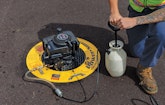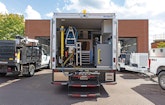
The team at Upper Montgomery Joint Authority in Pennsburg, Pennsylvania, has led a comprehensive overhaul of its wastewater collections and treatment systems. (Photography by Hannah Beier)
The Upper Montgomery Joint Authority’s infrastructure was aging, and a combination of substantial inflow and infiltration along with increased frequency of weather events was causing problems for the entire community.
For UMJA, the solution wasn’t as simple as fixing an I&I...









